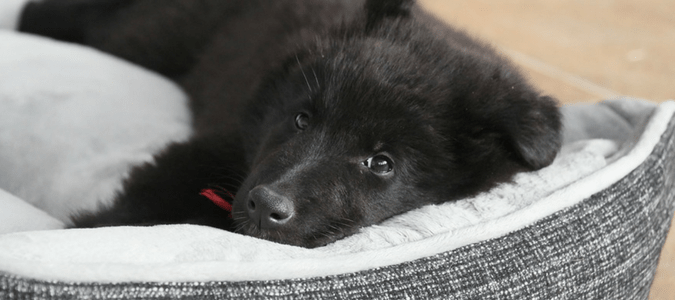
Many of us consider our pets a part of our family. With countless “dogs-welcomed” restaurants, trails, large dog parks and training and boarding facilities, it’s no wonder that so many cities are seeing an increase in puppy adoptions.
Welcoming a dog into your home involves research and planning, particularly if you have decided you’d prefer to adopt a puppy. From proper nutrition to adequate amounts of exercise to an endless amount of love and care, it’s your duty to ensure your pet is cared for. Thinking about the best room temperature for puppies and older pets is one way to make sure your furry friends stay happy and healthy.
What’s the Best Room Temperature for Puppies?
It might sound silly, but even the smallest factors, like your home’s temperature, are important aspects in maintaining your dog’s overall health, particularly if you have a puppy. Let’s discuss what new dog owners need to know about how to ensure your pet is comfortable throughout the day.
When Can Puppies Regulate Their Body Temperature?
Similar to other animals, newborn dogs depend on their mother for survival. For a week or two after they are born, puppies are unable to control their own body temperature. In most cases, the mother will remain close to her babies, so the temperature of the room they are in is not important. If the mother has a strong attachment to her owners, she may leave her puppies. If that happens, you can move both the puppies and the mother closer to you to ensure the newborn dogs are safe.
The first four days after a dog is born is the most critical time to maintain a temperature of 85 to 90 degrees Fahrenheit near the puppies’ whelping box. Using a heat lamp is usually adequate to maintain this consistent temperature, which can be lowered to about 80 degrees when the puppies are a week to ten days old and 72 degrees when the puppies are a month old. You can attach a household thermometer inside the whelping box to know if you need to make adjustments. Keep in mind that the larger the litter, the less you will need to modify the room temperature, since the newborn dogs will huddle together for warmth.
Of course, the mother will need to leave her puppies to relieve herself, and the puppies will be fine for this amount of time alone. Healthy puppies will gain weight and be relatively quiet. One way you might be able to tell that that something is wrong with a litter of puppies is if you hear crying or if they seem restless. Once you have passed the one-month mark, your puppies will be comfortable in the same temperatures as the human members of your household.
What Is The Best Temperature For Dogs While You Are Away?
What if you adopt a puppy that’s more than a month old, or you bring an adult dog into your home? According to the Alliance to Save Energy, the recommended thermostat setting ranges from 78 degrees in the summer and 69 degrees in the winter. Just like with humans, however, the best temperature for your dog will depend on various factors.
During your pet’s yearly checkup, your veterinarian can highlight any potential issues, such as arthritis, which may be worse during more extreme weather. Each dog has a different threshold of comfort, depending on factors such as level of body fat, activity level, and overall health. What is an ideal room temperature for puppies is not necessarily the best for elderly animals. Older dogs or dogs who have arthritis may be less tolerant of extreme temperatures than other pets. Short-haired pets may have a harder time during the colder months, while longer-haired dogs could suffer during the warmer months. Pets who have been diagnosed with hormonal imbalances, kidney or heart disease or diabetes may have a more difficult time keeping a regular body temperature and may be more susceptible to changes in weather.
After you have done your research, check with your vet to make sure that your thermostat is set at a temperature that’s safe for your pet.
Importance Of Maintaining A Consistent Temperature
Despite their extra layer of fur, dogs can also get cold when the temperature drops. In fact, if it’s cold for you—the owner—it’s probably too cold for your dog. Just like humans, dogs don’t respond well to abrupt changes in temperature or environment. Because of this, it’s important to maintain consistent temperatures in your home throughout the day. So if you’re leaving for the day, leave the thermostat as is. Your dog will be more comfortable if it’s left alone.
Bring Your Dog Indoors When Temperatures Drop
In most southern states, dogs can spend a majority of their time outside, regardless of the season. That said, temperatures can still drop below freezing. If your dog is typically kept outdoors, invite your pup inside on nights when the temperature drops to new extremes. And keep your furry friend indoors all night. Allowing for entry and reentry will only hurt your pets later, as a quick change from hot to cold will increase their chances of getting sick.
When you do bring your dog indoors, be sure to towel him down and remove any excess moisture from its fur. Just like his owner, even dogs can get cold overnight in a heated home, so be sure to line his bed with blankets and extra layers of warmth.
If you do need to keep your dog outside, make sure your pet always has access to fresh water and that you add adequate bedding that is warm and dry. Inspect your pet’s outdoor shelter to make sure the opening does not allow cold wind to directly blow inside. You may need to change bedding to make sure it remains warm and dry. Avoid the use of heated mats, space heaters, or heat lamps, because of the risk of fire or injury.
Dietary Considerations
While our discussion focuses on temperature, it’s important to consider the dog’s diet as well. Outdoor dogs burn more calories in the winter to keep their bodies warm, so if kept outside during the colder months, they’ll need an additional 10 to 15 percent more calories daily to get the nutrients they need. Our winters in warmer climates might not seem threatening, but the weather change is significant enough to require certain changes and special care.
The opposite is true as well. If you see your dog panting while indoors, it doesn’t necessarily mean he’s dehydrated. Even so, you’ll want to be sure your dog is drinking enough water to stay properly hydrated.
Leave The Fan Off
Unlike humans, dogs might not feel the breeze produced by your fan. In fact, dogs with thick coats won’t feel the chill at all. Leaving the fan on all day won’t change your dog’s temperature. Instead, consider lowering the temperature to the highest degree where you’d be comfortable and leave it there. Turning the thermostat higher and leaving the fan running will leave your dog feeling dehydrated, not comfortable.
ABC Keeps Your Entire Household Comfortable
Your furry friends mean the world to you, so be sure to take their comfort and safety into consideration. If you are not sure whether your house is comfortable for your pets, let the experts at ABC Home & Commercial Services come out and take a look. Our experts deliver quality, reliable service 24 hours a day, 7 days a week. From repairs and upkeep to system replacements to energy saving improvements, ABC Home & Commercial Services can help with all of your air conditioning and heating needs.
